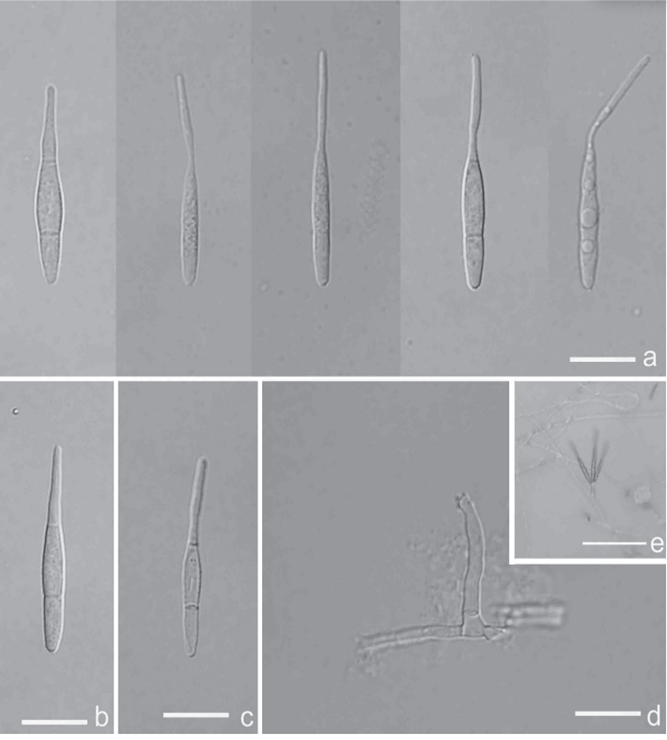 127
127
Antidactylaria minifimbriata Z.F. Yu, M. Qiao & R.F. Castañeda, sp. Nov.2021
Index Fungorum number: IF556121
Facesoffungi Number No: FoF05735
Holotype: YMF 1.04578
Morphological description :
Asexual morph: hyphomycetous. Colonies on CMA white to rosy buff, reverse buff, attaining 2.7 cm diam. after 20 days at 25 °C. Mycelium partly superficial, partly immersed, composed of branched, slender, septate, hyaline, smooth-walled hyphae. Conidiophores semi-macronematous, mononematous, cylindrical, straight or slightly flexuous, unbranched, 0–1(–2)-septate, hyaline or pale brown, smooth, sometimes reduced to conidiogenous cells. Conidiogenous cells polyblastic, sympodial elongated, terminal, denticulate, denticles cylindrical, minute fringed. Conidia solitary, acrogenous, narrow obclavate, cylindrical to fusiform, attenuate, rostrate or caudate towards the apex, 27.7–40 × 2.5–3.3 µm, rostrum 10–19 × 1–1.8 µm, 2-septate, hyaline to subhyaline, smooth-walled, with a minute basal frill. Sexual state:unknown.
Culture characteristics:
Habitat: on submerged leaves,
Distribution: .China, Hainan Province, Diaoluoshan National Forest Park
GenBank: lsu MK577808; its MK569506.
Notes:Morphologically, Antidactylaria minifimbriata is similar to A. ampulliforma (= Isthmolongispora ampulliformis) in conidial shape, but can be easily distinguished from it by having wider conidia (2.5–3.3 vs. 2.0–2.5 µm) and longer rostrum (10.0– 19.0 vs. 6.0–10.0 µm) (Yen et al. 2017).
Reference: [1] Qiao, M. , Zheng, H. , Guo, J. S. , Castaeda-Ruiz, R. F. , Xu, J. P. , & Peng, J. , et al. (2021). Two new asexual genera and six new asexual species in the family microthyriaceae (dothideomycetes, ascomycota) from china. MycoKeys, 85, 1-30.

Antidactylaria minifimbriata (Holotype YMF 1.04578) a–c conidia d conidiophore and conidiogenous cell e conidia on conidiophor under low objective. Scale bars: 10 µm (a–d); 50 µm (e).

